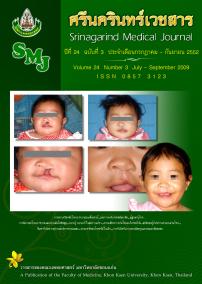ThaiScience
ThaiScience
SRINAGARIND MEDICAL JOURNAL
Volume 35, No. 05, Month SEPTEMBER, Year 2020, Pages 552 - 560
Accuracy of magnetic resonance imaging in diagnosis of morbidly adherent placenta
Chalida Aphinives, Thaiwat Tatsanawiwat, Jiraporn Srinakarin, Ratana Komwilaisak, Pilaiwan Kleebkaow
Abstract Download PDF
Background and Objective: To determine the sensitivity and specificity of MRI findings for detecting of morbidly adherent placenta. Methods: A retrospective review of the patients who underwent pelvic MRI during pregnancy between January 2004 and June 2014. Thirty-one image sets that met the following inclusion criteria were enrolled in the study. MR imaging findings included uterine bulging, intraplacental hemorrhage, placenta heterogeneity, intraplacental dark bands, present of myometrium plane were reviewed by two investigators blinded to pregnancy outcome. Results: In thirty-one image sets of pelvic MRI in the pregnant patients. Sensitivity, specificity, PPV, NPV and kappa value of MRI features had calculated: uterine bulging (90.9%, 75%, 66.7%, 93.8% and 0.74 respectively); intraplacental hemorrhage (81.8%, 89. 5%, 81. 8%, 89. 5% and 0. 78); placental heterogeneity (100%, 15%, 39.3%, 100% and 0.34); intraplacental dark bands (100%, 55%, 55%, 100% and 0.49); partial/absent myometrium under placenta (100%, 80%, 73.3%, 100% and 0.83), respectively.Accuracy of MRI to diagnosed morbidly adherent placenta was 83.8% (95% CI 66.2%-94.5%) with moderate interobserver agreement (kappa value 0.58).Conclusion: Uterine bulging, intraplacental hemorrhage and partial/absent myometrium plane may be the keys criteria to diagnosis on pelvic MRI. Placental homogeneity and absent intraplacental dark band on T2WI may be exclusive criteria
Keywords
morbidly adherent placenta placenta accreta placenta increta placenta percreta pelvic MRISRINAGARIND MEDICAL JOURNAL
Published by : Faculty of Medicine, Khon Kaen University
Contributions welcome at : http://www.smj.ejnal.com/e-journal/journal/index.php
